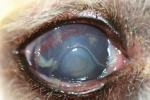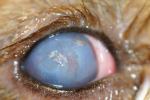Signs of Dry Eye
The appearance of Dry Eye can be quite varied and subtle, especially early in the disease. It is better for the health of the dog’s eyes to pick up the problem early, so that more tear tissue remains and fewer abnormal changes to the eyes develop. The earlier the problem is diagnosed and treated, the better the long term outlook for the dog’s eyes.
Veterinary specialists in ophthalmology recommend testing virtually all sore eyes for Dry Eye, to make sure the condition is diagnosed as early as possible.
If your dog has any of the following signs, you should make an appointment with your veterinarian. Remember to tell your veterinarian if your dog has experienced any previous eye problems.
Signs to look out for
- Uncomfortable eyes – your dog may blink excessively, rub its eyes or try to keep its eyes closed
- Eyes red and inflamed
- Discharge from the eyes
- Dry looking eyes
- Frequent conjunctivitis, eye infections or corneal ulcers
- Dark pigment on the surface of the eyes
- Prominent blood vessels on the surface of the eyes
As dogs with Dry Eye are prone to getting eye infections and conjunctivitis, Veterinary specialists in ophthalmology recommend testing for Dry Eye in all dogs that have had more than one eye infection in any 12-month period. Otherwise, Dry Eye could be missed and the dog only treated for the infection, and not the ongoing underlying problem.







